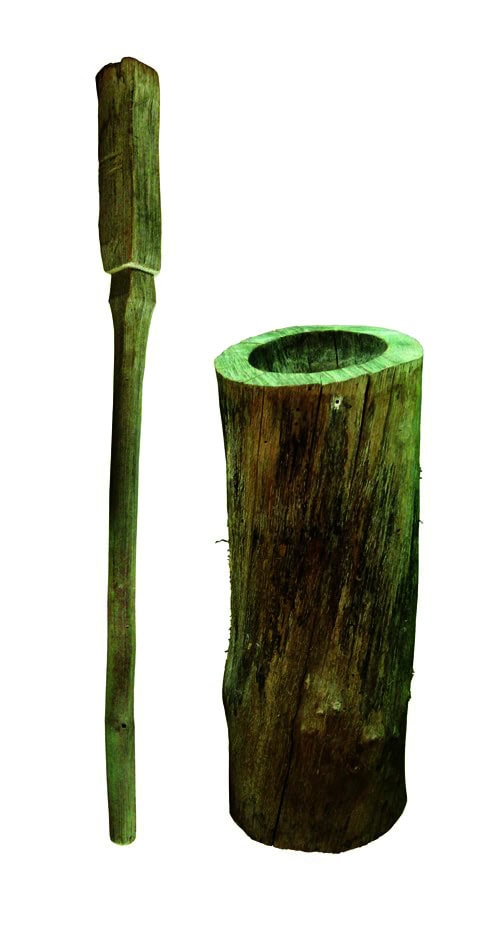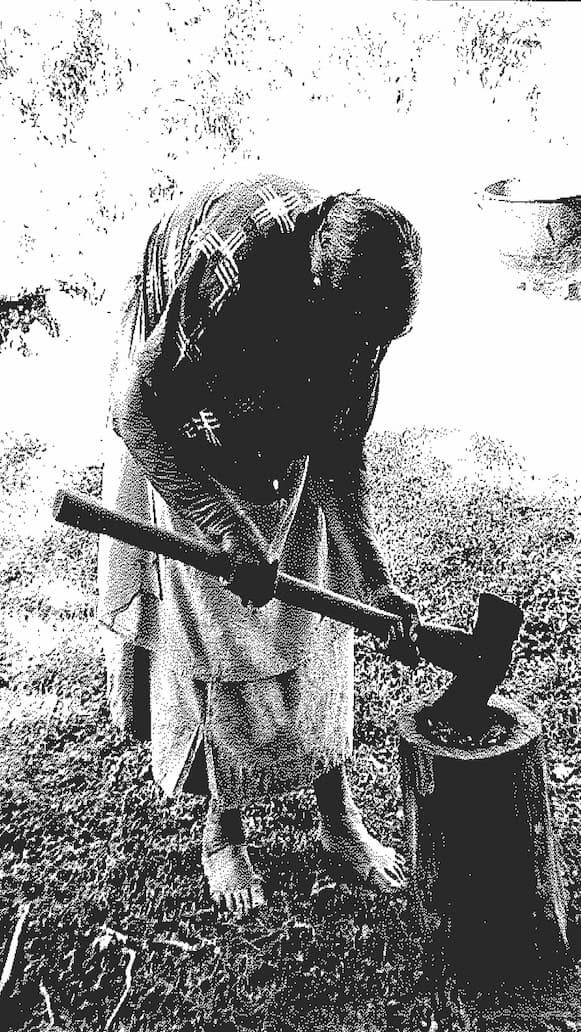
Choctaw Mortar and Pestle
Iti FabvssaPublished July 1, 2016In 1974, as a second year graduate student at Southern Methodist University, I visited my grandmother – Louisa Willis Watkins – at her home on Cypress Creek west of Wright City, Oklahoma. I spent the day listening to my grandmother talk about family histories, listening to tales about ghosts and “the old ways,” and generally soaking in whatever she wanted to tell me. My aunt translated from my grandmother’s Choctaw into my English, and from my English to Choctaw.
Later in the afternoon, after the laundry had been finished and the cast iron cooking pot removed, we talked about corn and its importance in Choctaw foodways. My grandmother talked about the tools she used long ago to process corn prior to it being cooked. She pointed to an upright piece of tree trunk in the corner of the yard – the old mortar (Choctaw word “kiti”) and pestle (“kitush”) that had been in her front yard forever. She also brought out her three split-cane baskets that she used to sift, winnow, and hold the processed corn meal.
My brother, sister and I had played with the mortar and pestle as kids, not really understanding what they were. My uncle had told us about it at times, but much of what he told us must have passed out of our heads rather quickly, as some stories were likely to do. But that afternoon in 1974, I was curious and asked my grandmother what she knew about making them.
Since it was not possible for me to make a full-sized kiti, we started with a small stump (about 14 inches high) of red oak. Normally a person would use a waist-high trunk of hickory or similar hardwood. Swanton (1931:40), in describing the materials used in making the mortar and pestle, noted that [h]ickory wood was the kind out of which they were usually made because it conveys the best taste to the food. Failing that, they employed oak, though it gives food a puckery taste. Beech could be used but it was scarce, but some woods were not used because of the bad taste they communicate, in particular maple, which gives a taste “sufficiently bad to ruin one’s stomach.”
My grandmother used her axe to create a series of crossing and slightly overlapping chops into the top of the log, about one-quarter to three-eighths of an inch deep, in a circular area centered in the log top. The circular area was a little more than twice as wide as the axe face. We removed as much of the wood chopped out of the area as much as possible to create a depression. Then she scraped a handful of coals from the fire onto a piece of tree bark, and placed them in the depression. She fanned the coals to make the fire burn hotter. As the coals burned, she used the axe to widen the burning area, feeding the fiery coals with the dislodged wood chips. She also used the axe to shape the burned area into a circular basin, focusing the axe on areas that had been burned or blackened by the fire. We would alternately feed more coals to the growing basin and chop out the burned areas of the tree stump.
After a bit, my grandmother had me blow through a piece of water hose to further focus the fire, much like a blacksmith’s bellows. She said that the old Choctaw didn’t have water hoses, but would often use reeds or cleared river cane (the diaphragms between the nodes broken or burned through) to focus air to the fire in the same way as I used the hose.
When the basin was the diameter she wanted, we let the fire burn a while, adding small sticks and wood chips to keep the coals hot. She used the axe less often, but enough to get the basin shaped to a width and depth suitable to show me the second part of the process.
To begin the second basin, she used the axe in the center of the burned basin to begin another, smaller and deeper depression. The inner basin was where the secondary pounding of the corn kernels was focused, and the area where the finer corn meal would settle and be collected. Twigs were used to supplement the coals to further increase the heat of the fire, and the axe wielded time and time again until the basin was “deep enough.”
Ultimately, when viewed from the top, the inner basin was approximately five inches in diameter and three to four inches deeper than the surrounding basin into which it had been made. The surrounding basin was about ten inches in diameter and about three inches deep. The walls of the upper basin sloped toward the middle, inner basin. In cross section it was shaped like an inverted baby bottle nipple (only much larger!).


The pestle (“kitush”) was made from a long, slender piece of wood, usually from four to six feet long and from four to six inches in diameter. One end of the piece was left at its original diameter for a length of from eight to ten inches while the remaining length was trimmed to about two inches in diameter. The top portion provided weight for the downward “pounding” thrust, while the thinner portion more easily fit the hands and the smaller basin. The small end was rounded to shape to fit roughly within the smaller basin and served as the actually pounding surface of the kitush.
All of this work took about three hours, but the time flew by as if it were only minutes. My grandmother and I did not make a full-sized kiti or kitush, but we followed a process that Choctaw craftsmen had used for centuries to make the materials needed to process corn into meal. Though our “models” were much smaller than their full-sized cousins, they were faithful replicas. I took the kiti and the kitush back to my apartment in Dallas, and stored it in the attic of Dallas Hall on the Southern Methodist University campus during one of my subsequent moves. When I returned to campus in 2015 to give a public lecture in honor of the Department of Anthropology’s Golden Anniversary, I looked in the attic for that kiti, but it was nowhere to be found.
My grandmother passed away in 1982, and I have no idea what became of the kiti that stood in her front yard for so long. I received her three split-cane baskets after her death, and they hang in a place of honor in my living room here in Takoma Park, Maryland, on the outskirts of Washington, D.C. Each time I see a picture of someone using the mortar and pestle to process corn, I think of that afternoon in 1974 when my grandmother and I bonded over a bit of traditional cultural knowledge passed on through the generations.